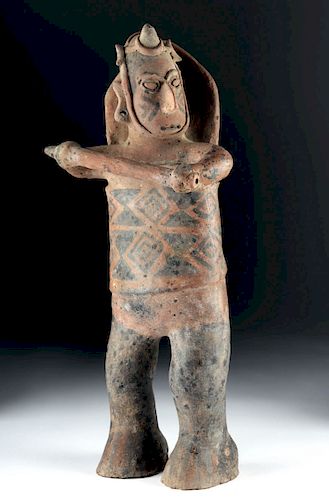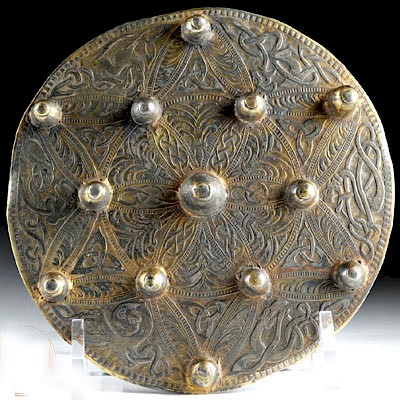Large Colima Pottery Standing Shamanic Warrior
Lot 92
About Seller
Artemis Fine Arts
686 S Taylor Ave, Ste 106
Louisville, CO 80027
United States
Selling antiquities, ancient and ethnographic art online since 1993, Artemis Gallery specializes in Classical Antiquities (Egyptian, Greek, Roman, Near Eastern), Asian, Pre-Columbian, African / Tribal / Oceanographic art. Our extensive inventory includes pottery, stone, metal, wood, glass and textil...Read more
Estimate:
$2,200 - $3,000
Absentee vs Live bid
Two ways to bid:
- Leave a max absentee bid and the platform will bid on your behalf up to your maximum bid during the live auction.
- Bid live during the auction and your bids will be submitted real-time to the auctioneer.
Bid Increments
| Price | Bid Increment |
|---|---|
| $0 | $25 |
| $300 | $50 |
| $1,000 | $100 |
| $2,000 | $250 |
| $5,000 | $500 |
| $10,000 | $1,000 |
| $20,000 | $2,500 |
| $50,000 | $5,000 |
| $100,000 | $10,000 |
| $200,000 | $20,000 |
About Auction
By Artemis Fine Arts
Jul 19, 2018
Set Reminder
2018-07-19 10:00:00
2018-07-19 10:00:00
America/New_York
Bidsquare
Bidsquare : Fine Antiquities/Ethnographic Art
https://www.bidsquare.com/auctions/artemis-gallery/fine-antiquities-ethnographic-art-3329
Featuring classical antiquities, ancient and ethnographic art from cultures encompassing the globe, plus fine art. Artemis Fine Arts info@artemisgallery.com
Featuring classical antiquities, ancient and ethnographic art from cultures encompassing the globe, plus fine art. Artemis Fine Arts info@artemisgallery.com
- Lot Description
Pre-Columbian, West Mexico, Colima, ca. 300 BCE to 300 CE. A tall, hand-built redware terracotta male warrior figure standing atop a pair of wide delineated legs. His broad hips and sturdy torso enable him to easily don protective barrel armor adorned in negative-resist triangular and concentric diamond motifs, with both upheld arms brandishing an imposing knob-headed club. His head is oriented to the left as if anticipating an attack at any moment, with similar black-painted facial marks across his cheeks, mouth, and brow. The figure wears a shamanic horn and a pair of crescent-shaped ornaments atop his forehead, all secured with straps across his chin and head which frame his stylized visage of coffee-bean-shaped eyes and a prominent nose. A large, spouted back panel extends up from the back of the barrel armor, giving the warrior an extra area of protection. A sizeable example replete with fine craftsmanship, expert presentation, and meticulous attention to detail. Size: 8.875" W x 20.75" H (22.5 cm x 52.7 cm).
Colima, located on Mexico's southwestern coast, was during this time part of the shaft tomb culture, along with neighbors to the north in Jalisco and Nayarit. In this culture, the dead were buried down shafts - 3 to 20 meters deep - that were dug vertically or near vertically through the volcanic tuff that makes up the geology of the region. The base of the shaft would open into one or more horizontal chambers with a low ceiling. These shafts were almost always dug beneath a dwelling, probably a family home, and seem to have been used as family mausoleums, housing the remains of many related individuals. This is a figure made to be placed inside those mausoleums, perhaps to mediate between the worlds of the living and the dead.
The sculptural creations of Colima are quite distinctive with smooth, rounded forms presenting remarkable consistency in their warm russet red hues. In addition, the sculpture of Colima is known for a wide range of postures and expressions, making them quite intriguing to us, even some 2000 years after their origination.
For a stylistically-similar example, please see The Museum of Fine Arts, Houston, accession number 2015.299: https://www.mfah.org/art/detail/129903?returnUrl=%2Fart%2Fsearch%3Fartist%3DColima
Provenance: private New York, New York, USA collection; ex-Joseph Ronar collection, Montreal, Quebec, Canada, famous archaeologist (1948-1993)
All items legal to buy/sell under U.S. Statute covering cultural patrimony Code 2600, CHAPTER 14, and are guaranteed to be as described or your money back.
A Certificate of Authenticity will accompany all winning bids.
We ship worldwide and handle all shipping in-house for your convenience.
#133722Repairs to legs, torso, armor, club, arms, and back panel behind head with some new material, resurfacing, and overpainting along break lines. Surface wear and abrasions commensurate with age, fading to some areas of pigmentation, small chips to legs, feet, arms, head, club, and spout, and minor areas of fading to pigmentation. Nice earthen and mineral deposits throughout.Condition
- Shipping Info
-
All shipping is handled in-house for your convenience. Your invoice from Artemis Gallery will include shipping calculation instructions. If in doubt, please inquire BEFORE bidding for estimated shipping costs for individual items.
-
- Buyer's Premium



 EUR
EUR CAD
CAD AUD
AUD GBP
GBP MXN
MXN HKD
HKD CNY
CNY MYR
MYR SEK
SEK SGD
SGD CHF
CHF THB
THB


















